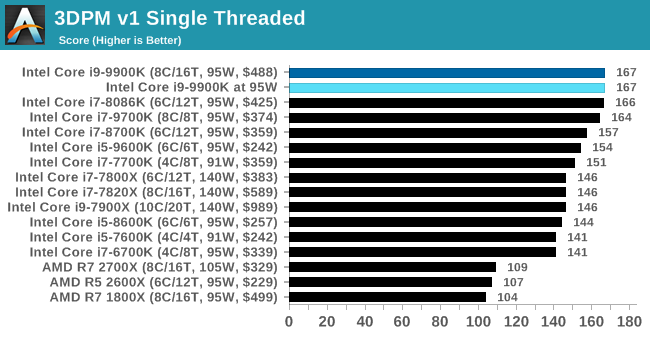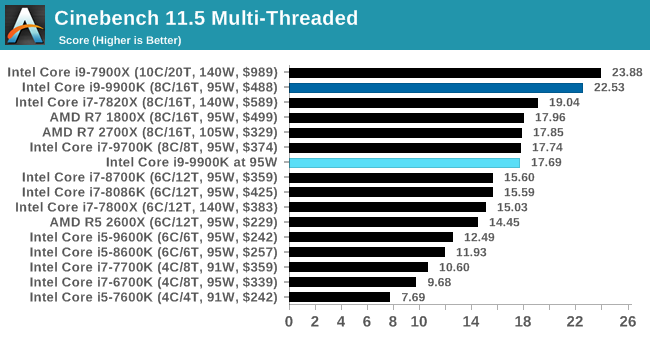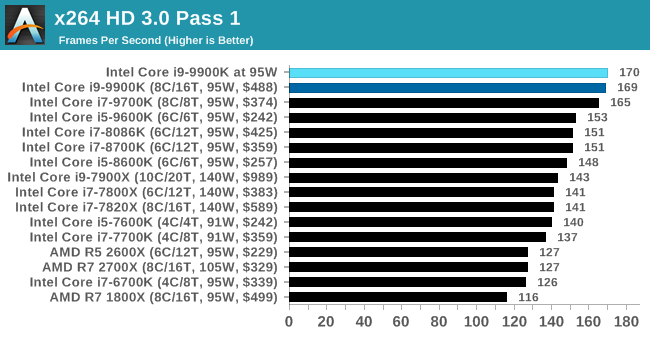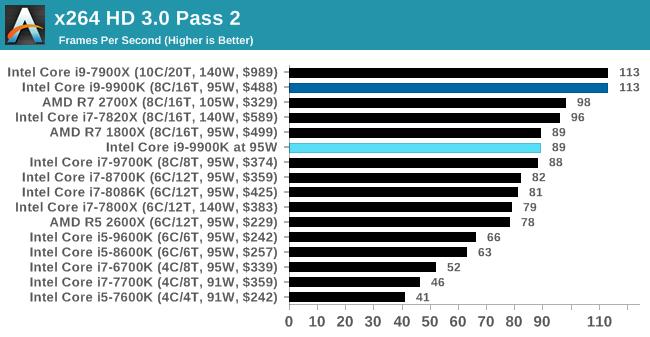The Intel Core i9-9900K at 95W: Fixing The Power for SFF
by Ian Cutress on November 29, 2018 8:00 AM ESTCPU Performance: Legacy Tests
We have also included our legacy benchmarks, representing a stack of older code for popular benchmarks.
All of our benchmark results can also be found in our benchmark engine, Bench.
3DPM v1: Naïve Code Variant of 3DPM v2.1
The first legacy test in the suite is the first version of our 3DPM benchmark. This is the ultimate naïve version of the code, as if it was written by scientist with no knowledge of how computer hardware, compilers, or optimization works (which in fact, it was at the start). This represents a large body of scientific simulation out in the wild, where getting the answer is more important than it being fast (getting a result in 4 days is acceptable if it’s correct, rather than sending someone away for a year to learn to code and getting the result in 5 minutes).
In this version, the only real optimization was in the compiler flags (-O2, -fp:fast), compiling it in release mode, and enabling OpenMP in the main compute loops. The loops were not configured for function size, and one of the key slowdowns is false sharing in the cache. It also has long dependency chains based on the random number generation, which leads to relatively poor performance on specific compute microarchitectures.
3DPM v1 can be downloaded with our 3DPM v2 code here: 3DPMv2.1.rar (13.0 MB)


x264 HD 3.0: Older Transcode Test
This transcoding test is super old, and was used by Anand back in the day of Pentium 4 and Athlon II processors. Here a standardized 720p video is transcoded with a two-pass conversion, with the benchmark showing the frames-per-second of each pass. This benchmark is single-threaded, and between some micro-architectures we seem to actually hit an instructions-per-clock wall.












101 Comments
View All Comments
TechSideUp - Sunday, December 2, 2018 - link
Can you show me where your getting this i9-9900k for $488? Lolpeevee - Monday, December 3, 2018 - link
" Alex Yee, a researcher from NWU and now software optimization developer, that I realized that he has optimized the software like crazy to get the best performance."What CPU he optimized it for? Let me guess... the one he has in his room.
tviceman - Monday, December 3, 2018 - link
I'd like to see what kind of performance gains may be had with an undervolt when TDP limited.TheJian - Tuesday, December 4, 2018 - link
I think people are confusing WATTS USED with TDP (amount of HEAT a chip puts off that your HSF or case etc has too be able to accommodate to cool said chip). They are telling manufacturers of laptops, pc's etc how good their cooling design needs to be to keep the chip from heating up.THERMAL DESIGN POWER (point might be more accurate, as some use it), is just as it sounds. THERMAL, er, uh, HEAT. Get it? I'm confused by everyone's confusion...LOL.
https://www.windowscentral.com/what-tdp-and-why-sh...
Perhaps a bit better explanation than anandtech is providing. Maybe they need an A+ course?
"TDP ≠ power draw?"
"Not quite, no. TDP doesn't equate to how much power will be drawn by the component in question, but that doesn't mean you can't use the value provided as an estimation."
"TDP is not — however — a direct measure of how much power a component will draw, but it can be a good indicator."
So, don't expect watts PULLED from a wall to equal a quoted TDP. That isn't what it is, although it may come close to meaning it...ROFL.
If you had a 100% efficient chip (as someone else noted isn't possible...yet?), your chips TDP rating would be ZERO. It would not require anything to cool it. See the point?
https://en.wikipedia.org/wiki/Thermal_design_power
"The thermal design power (TDP), sometimes called thermal design point, is the maximum amount of heat generated by a computer chip or component (often the CPU or GPU) that the cooling system in a computer is designed to dissipate under any workload."
Not exactly watts used right?
https://fullforms.com/TDP
"What does TDP mean?
Thermal Design Power (TDP), sometimes called Thermal Design Point, is a metric that is expressed in watts. TDP refers to the amount of power/heat a cooling system (like fan, heatsink) is expected to dissipate to prevent overheating."
Again, not watts used. I could point to another dozen, but people should get the point. Despite whatever Intel/AMD think it means year to year (ROFL), it's heat.
https://www.overclockers.com/forums/showthread.php...
Same story from OC people. To each his own I guess, but many seem confused about why things blow past tdp (because it's not WATTS). What is the chips temp when it blows past those TDP numbers at stock settings? Is it 150 instead of 95 or whatever? I mean if Dell or someone designs their slim pc's for 95w it likely won't work to well if it's going to 150 temps with a box that is designed to cool 95-100w right? Again, the definition used here really don't work IMHO (and everyone else I seem to look up...LOL). But hey, maybe my old A+ test was wrong (I'm old, maybe I'm just not recalling things correctly, and all the web is wrong too) :) I doubt it ;)
Gastec - Wednesday, June 19, 2019 - link
Perpetuum mobile IS impossible. And I don't want a CPU that's advertised as consuming 95W to 110W (give more than take the PSU inefficiency and other losses on the pipe) to automatically overclock to 170 W because of review benchmarks. I want it to be set BY DEFAULT at max. 95-110W and I also want it to do 5GHz on all cores @ 95-110W, as advertised:) Then I would pay 490€ for it.DennisBaker - Tuesday, December 4, 2018 - link
I wanted to build a new PC on Black Friday, and I bought an i9-9900k. I never overclock and typically buy a locked/non-k CPU but couldn't wait until next year. I also always use a SFF case (Cooler Master Elite 130).This is a great article, but I'm not sure how to actually set the bios for a 95w max cpu setting.
I have the Asrock z390 phantom gaming-itx/ac motherboard:
http://asrock.pc.cdn.bitgravity.com/Manual/Z390%20...
I've been googling without success and figured I would just ask here if there is a general guide for this.
DennisBaker - Tuesday, December 4, 2018 - link
Set to:Long Duration Power Limit: 95
Long Duration Maintained: Auto
Short Duration Power Limit: 95
Seems like that should work.
0ldman79 - Thursday, December 6, 2018 - link
I guess the 95w limit prevented whatever resource snag or thermal throttling issues that was happening with the unlimited version.That would explain the benches where it won vs the unlimited 9900k.
HikariWS - Thursday, December 13, 2018 - link
Great article! I've been guessing about turbo values for years and this aticle answered it all!!Of course we need more transparency from Intel, I suppose this info is left for marketers to release and they think we'd not understand, so they just leave it hidden.
It's great how the same chip can be used on a small form factor and on a big E-ATX case. Modern turbo makes manual overclocking almost not needed, left for watercooling or maybe some manual Vcore setting.
It's basicly a matter of having a good case, a great cooler, and live in Europe to be able to keep 4700MHz all the time!
I wish Intel would release a top performing CPU with 4 core and no IGP, that would do 4.5GHz base and 5.5GHz All Core Turbo without watercooling. We don't need more than 4 cores.
misources - Sunday, May 10, 2020 - link
Nice article about Intel Core i9. please visit my site for more tutorial www.misources.com